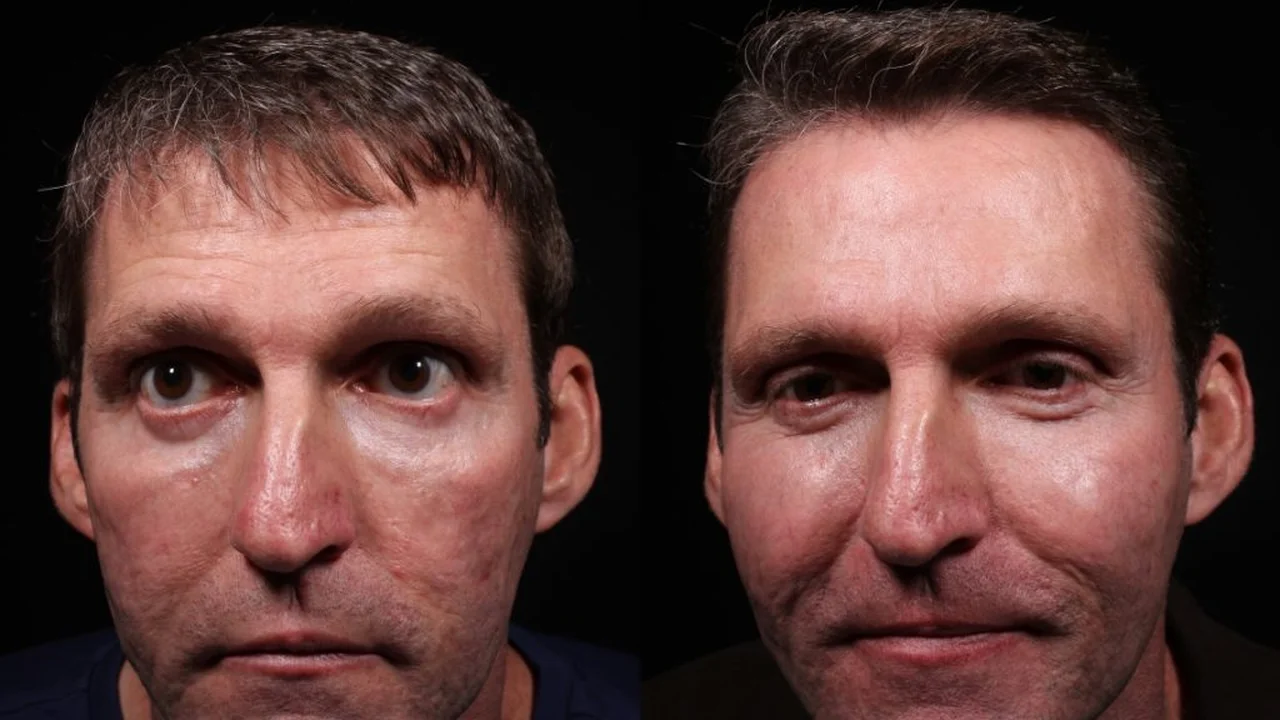Cheek Implants: Restoring Volume and Youthfulness

Understanding Surgical Facial Rejuvenation Procedures
Surgical facial rejuvenation encompasses a range of procedures designed to address the visible signs of aging and restore a more youthful appearance. These procedures can target various areas of the face, including the forehead, cheeks, jawline, and neck. The goal is to correct wrinkles, sagging skin, volume loss, and other age-related changes. Surgical options offer more dramatic and long-lasting results compared to non-surgical treatments, making them a popular choice for individuals seeking significant improvements.
Different Types of Surgical Facial Rejuvenation
Several surgical techniques fall under the umbrella of facial rejuvenation. Some of the most common include:
- Facelift (Rhytidectomy): Addresses sagging skin, deep wrinkles, and jowls in the lower face and neck.
- Brow Lift (Forehead Lift): Corrects drooping eyebrows, forehead wrinkles, and frown lines.
- Eyelid Surgery (Blepharoplasty): Improves the appearance of the eyelids by removing excess skin, fat, or muscle.
- Cheek Implants (Malar Augmentation): Enhance cheek volume and definition, restoring a youthful contour.
- Chin Augmentation (Mentoplasty): Improves the balance and proportion of the face by altering the size or shape of the chin.
- Neck Lift (Platysmaplasty): Tightens loose skin and muscles in the neck, reducing the appearance of a "turkey neck."
- Fat Grafting (Facial Fat Transfer): Adds volume to areas of the face that have lost fat due to aging.
Benefits of Surgical Facial Rejuvenation
The benefits of surgical facial rejuvenation extend beyond just physical appearance. These procedures can significantly improve self-esteem, confidence, and overall quality of life. Specific benefits include:
- Reduced Wrinkles and Fine Lines: Surgical procedures can effectively smooth out wrinkles and fine lines, creating a more youthful complexion.
- Improved Skin Elasticity: By tightening underlying tissues and removing excess skin, surgical rejuvenation can restore skin elasticity and firmness.
- Enhanced Facial Contours: Procedures like cheek implants and chin augmentation can enhance facial contours and create a more balanced and harmonious appearance.
- Restored Volume: Fat grafting and other volume-enhancing techniques can replenish lost facial volume, restoring a more youthful and vibrant look.
- Long-Lasting Results: Surgical results are typically longer-lasting than those achieved with non-surgical treatments.
Cheek Implants Restoring Volume and Youthfulness in Detail
Cheek implants, also known as malar augmentation, are a surgical procedure designed to enhance the volume and definition of the cheeks. This procedure can restore a more youthful and balanced facial appearance by addressing age-related volume loss or congenital deficiencies. Cheek implants are available in various shapes and sizes, allowing for customized results that complement individual facial features.
Understanding the Importance of Cheek Volume
The cheeks play a crucial role in defining facial aesthetics. Full, well-defined cheeks contribute to a youthful and attractive appearance. As we age, the fat pads in our cheeks tend to diminish, leading to a loss of volume and a flattened or sunken appearance. This volume loss can also contribute to the formation of nasolabial folds (laugh lines) and a general sagging of the lower face.
Types of Cheek Implants Available
Cheek implants come in different materials and shapes, each offering specific benefits and aesthetic outcomes. The most common types of cheek implants include:
- Silicone Implants: These are the most widely used type of cheek implant. They are made of solid silicone and are available in various shapes and sizes. Silicone implants are biocompatible and can be easily removed if necessary.
- Porex Implants: These implants are made of porous polyethylene, which allows for tissue ingrowth. This integration helps to secure the implant in place and reduces the risk of movement.
- ePTFE Implants (Gore-Tex): These implants are made of expanded polytetrafluoroethylene, a soft and flexible material. They are also porous, allowing for tissue ingrowth and secure placement.
In addition to the material, cheek implants also come in different shapes, including:
- Malar Implants: These implants are placed directly on the cheekbone (malar bone) to enhance cheek projection and definition.
- Submalar Implants: These implants are placed below the cheekbone to fill in hollows and improve the overall contour of the cheeks.
- Combined Implants: Some implants combine both malar and submalar augmentation to achieve a more comprehensive enhancement.
Cheek Implant Procedure: What to Expect
The cheek implant procedure typically involves the following steps:
- Consultation: A thorough consultation with a qualified plastic surgeon is essential to discuss your goals, assess your facial anatomy, and determine the most appropriate type and size of implant.
- Anesthesia: The procedure is usually performed under general anesthesia or local anesthesia with sedation.
- Incision: The surgeon will make an incision either inside the mouth (intraoral incision) or on the outside of the face, typically along the lower eyelid crease (transcutaneous incision). The choice of incision depends on the type of implant and the surgeon's preference.
- Implant Placement: The surgeon will create a pocket over the cheekbone and carefully insert the implant.
- Closure: The incision is closed with sutures.
Recovery After Cheek Implant Surgery
The recovery period after cheek implant surgery typically involves some swelling, bruising, and discomfort. Pain medication can help manage any pain. You will likely need to wear a compression garment to minimize swelling and support the healing process. It is important to follow your surgeon's instructions carefully to ensure a smooth and successful recovery. Most patients can return to work and other normal activities within a week or two.
Product Recommendations for Post-Surgical Cheek Implant Care
Proper post-operative care is crucial for optimizing healing and ensuring the best possible results after cheek implant surgery. Here are some product recommendations to aid in your recovery:
SkinCeuticals C E Ferulic
Product Description: SkinCeuticals C E Ferulic is a potent antioxidant serum that helps protect the skin from environmental damage and promotes collagen production. It contains a combination of vitamin C, vitamin E, and ferulic acid to neutralize free radicals and improve skin tone and texture.
Use Case: Apply a few drops of SkinCeuticals C E Ferulic to the face and neck each morning after cleansing. This serum can help protect the skin from sun damage and promote healing after surgery.
Product Comparison: Compared to other antioxidant serums, SkinCeuticals C E Ferulic is known for its high concentration of active ingredients and its proven effectiveness in clinical studies. While it is more expensive than some other options, its superior performance makes it a worthwhile investment.
Detailed Information:
- Key Ingredients: L-Ascorbic Acid (Vitamin C), Alpha Tocopherol (Vitamin E), Ferulic Acid
- Benefits: Protects against environmental damage, improves skin tone and texture, reduces wrinkles and fine lines.
- Price: Approximately $166 per 1 fl oz bottle.
Alastin Restorative Skin Complex
Product Description: Alastin Restorative Skin Complex is a skincare product designed to promote collagen and elastin production, improve skin elasticity, and reduce the appearance of fine lines and wrinkles. It contains TriHex Technology, a proprietary blend of peptides that supports the skin's natural ability to repair and regenerate.
Use Case: Apply Alastin Restorative Skin Complex to the face and neck twice daily after cleansing. This product can help accelerate healing and improve the overall appearance of the skin after cheek implant surgery.
Product Comparison: Alastin Restorative Skin Complex stands out for its unique TriHex Technology, which has been clinically proven to stimulate collagen and elastin production. It is a more targeted approach to skin rejuvenation compared to general moisturizers.
Detailed Information:
- Key Ingredients: TriHex Technology, Palmitoyl Tripeptide-1, Palmitoyl Hexapeptide-12
- Benefits: Stimulates collagen and elastin production, improves skin elasticity, reduces fine lines and wrinkles.
- Price: Approximately $195 per 1 oz bottle.
EltaMD UV Clear Broad-Spectrum SPF 46
Product Description: EltaMD UV Clear Broad-Spectrum SPF 46 is a lightweight, oil-free sunscreen that provides broad-spectrum protection against UVA and UVB rays. It is formulated with zinc oxide and octinoxate to protect the skin from sun damage without clogging pores.
Use Case: Apply EltaMD UV Clear Broad-Spectrum SPF 46 liberally to the face and neck every morning, even on cloudy days. Sunscreen is essential for protecting the skin from sun damage after any surgical procedure.
Product Comparison: EltaMD UV Clear is a popular choice among dermatologists and skincare professionals due to its lightweight formula, broad-spectrum protection, and non-comedogenic properties. It is a superior option compared to many other sunscreens that can be heavy or irritating.
Detailed Information:
- Key Ingredients: Zinc Oxide, Octinoxate
- Benefits: Provides broad-spectrum sun protection, prevents sunburn and sun damage, suitable for sensitive skin.
- Price: Approximately $37 per 1.7 oz bottle.
Arnica Montana
Product Description: Arnica Montana is a homeopathic remedy that is often used to reduce bruising and swelling after surgery. It is available in various forms, including tablets, creams, and gels.
Use Case: Take Arnica Montana tablets as directed by your healthcare provider or apply Arnica cream or gel to the affected areas several times a day. This remedy can help accelerate the healing process and reduce discomfort after cheek implant surgery.
Product Comparison: Arnica Montana is a natural remedy that has been used for centuries to treat bruising and swelling. While its effectiveness is not universally accepted, many people find it helpful for managing post-operative symptoms.
Detailed Information:
- Key Ingredients: Arnica Montana extract
- Benefits: Reduces bruising and swelling, relieves pain and discomfort.
- Price: Varies depending on the form and brand.
Comparing Cheek Implant Options Material Shape and Size
Choosing the right cheek implant involves carefully considering the material, shape, and size. Each factor plays a crucial role in achieving the desired aesthetic outcome. Here's a detailed comparison:
Material Comparison: Silicone vs Porex vs ePTFE
Silicone Implants:
- Pros: Biocompatible, easy to remove if necessary, available in a wide range of shapes and sizes, generally less expensive than other options.
- Cons: Risk of capsule formation (scar tissue around the implant), potential for movement or rotation.
Porex Implants:
- Pros: Tissue ingrowth for secure placement, reduced risk of movement or rotation, natural-feeling results.
- Cons: More difficult to remove if necessary, potential for infection if tissue ingrowth is incomplete.
ePTFE Implants (Gore-Tex):
- Pros: Soft and flexible, tissue ingrowth for secure placement, natural-feeling results.
- Cons: More difficult to remove if necessary, potential for infection if tissue ingrowth is incomplete.
Shape Comparison: Malar vs Submalar vs Combined
Malar Implants:
- Ideal For: Enhancing cheek projection and definition, creating a more sculpted appearance.
- Placement: Directly on the cheekbone (malar bone).
- Results: More prominent cheekbones, improved facial contour.
Submalar Implants:
- Ideal For: Filling in hollows and improving the overall contour of the cheeks, restoring volume to the midface.
- Placement: Below the cheekbone.
- Results: Fuller cheeks, more youthful appearance.
Combined Implants:
- Ideal For: Achieving a comprehensive enhancement by addressing both cheek projection and volume loss.
- Placement: Both on and below the cheekbone.
- Results: More dramatic and balanced facial rejuvenation.
Size Considerations for Optimal Facial Harmony
Choosing the correct implant size is crucial for achieving natural-looking and balanced results. The surgeon will carefully assess your facial anatomy and discuss your goals to determine the most appropriate size. Factors to consider include:
- Facial Proportions: The implant size should be in harmony with your overall facial proportions.
- Desired Outcome: Do you want a subtle enhancement or a more dramatic transformation?
- Skin Elasticity: Skin elasticity can affect how well the skin stretches to accommodate the implant.
It's important to have realistic expectations and understand that the goal is to enhance your natural features, not to create an artificial or exaggerated look.
Potential Risks and Complications of Cheek Implant Surgery
Like any surgical procedure, cheek implant surgery carries certain risks and potential complications. It's important to be aware of these risks before undergoing the procedure. Common risks include:
- Infection: Infection can occur at the incision site or around the implant. Antibiotics are typically used to treat infections.
- Bleeding: Excessive bleeding can occur during or after surgery.
- Swelling and Bruising: Swelling and bruising are common after surgery and usually subside within a few weeks.
- Nerve Damage: Nerve damage can cause numbness or tingling in the cheeks or face. This is usually temporary but can be permanent in rare cases.
- Implant Displacement: The implant can shift out of position, requiring revision surgery.
- Capsule Formation: Scar tissue can form around the implant, causing it to become hard or distorted. This may require surgical removal of the capsule.
- Asymmetry: The cheeks may not be perfectly symmetrical after surgery.
- Poor Scarring: Scars can be visible or raised, especially if the incision is made on the outside of the face.
Choosing a qualified and experienced plastic surgeon can help minimize these risks and ensure the best possible outcome.
The Future of Surgical Facial Rejuvenation Advancements and Innovations
The field of surgical facial rejuvenation is constantly evolving, with new techniques and technologies emerging to improve results and minimize risks. Some of the exciting advancements in this area include:
- 3D Printing: 3D printing technology is being used to create custom-designed implants that perfectly fit individual facial anatomy. This allows for more precise and natural-looking results.
- Minimally Invasive Techniques: Minimally invasive techniques, such as endoscopic surgery, are being used to reduce scarring and recovery time.
- Stem Cell Therapy: Stem cell therapy is being explored as a way to regenerate damaged tissues and improve skin elasticity.
- Fat Grafting Enhancements: Refinements in fat grafting techniques are leading to more predictable and long-lasting volume restoration.
- Robotic Surgery: Robotic surgery is being used to enhance precision and control during complex facial rejuvenation procedures.
These advancements promise to make surgical facial rejuvenation even more effective, safer, and more personalized in the future.
Finding a Qualified Surgeon for Your Cheek Implant Procedure
Choosing a qualified and experienced plastic surgeon is crucial for a successful cheek implant procedure. Here are some tips for finding the right surgeon:
- Board Certification: Make sure the surgeon is board-certified by the American Board of Plastic Surgery (ABPS) or a similar organization.
- Experience: Look for a surgeon who has extensive experience performing cheek implant surgery.
- Before and After Photos: Review the surgeon's before and after photos to assess their aesthetic skills and results.
- Patient Reviews: Read online reviews and testimonials from other patients to get an idea of the surgeon's reputation and patient satisfaction.
- Consultation: Schedule a consultation with the surgeon to discuss your goals, ask questions, and assess their communication style and bedside manner.
- Facility Accreditation: Ensure that the surgical facility is accredited by a reputable organization.
Taking the time to find a qualified surgeon will increase your chances of achieving a safe and satisfying outcome.
Cost Considerations for Surgical Facial Rejuvenation
The cost of surgical facial rejuvenation procedures, including cheek implants, can vary depending on several factors, including:
- Surgeon's Fees: Surgeon's fees vary based on their experience, reputation, and location.
- Anesthesia Fees: Anesthesia fees depend on the type of anesthesia used and the length of the procedure.
- Facility Fees: Facility fees cover the cost of using the surgical facility.
- Implant Costs: The cost of the implants themselves can vary depending on the material and size.
- Pre-operative and Post-operative Care: Costs for pre-operative testing and post-operative medications and follow-up appointments.
It's important to discuss all costs with your surgeon upfront and to understand what is included in the total price. Many surgeons offer financing options to help make these procedures more affordable.
While cost is a factor, it should not be the primary consideration. Choosing a qualified and experienced surgeon is more important than finding the cheapest option.
Maintaining Your Results Long Term After Surgical Facial Rejuvenation
While surgical facial rejuvenation can provide long-lasting results, it's important to maintain your results through a healthy lifestyle and proper skincare. Here are some tips for maintaining your rejuvenated appearance:
- Sun Protection: Protect your skin from the sun by wearing sunscreen daily and avoiding prolonged sun exposure.
- Healthy Diet: Eat a healthy diet rich in fruits, vegetables, and antioxidants to support skin health.
- Regular Exercise: Regular exercise can improve circulation and promote collagen production.
- Skincare Routine: Follow a consistent skincare routine with high-quality products that are appropriate for your skin type.
- Non-Surgical Treatments: Consider non-surgical treatments, such as Botox, fillers, and laser resurfacing, to maintain your results and address any new signs of aging.
- Maintain a Stable Weight: Significant weight fluctuations can affect facial volume and skin elasticity.
By following these tips, you can help prolong the benefits of your surgical facial rejuvenation procedure and maintain a youthful and radiant appearance for years to come.
:max_bytes(150000):strip_icc()/277019-baked-pork-chops-with-cream-of-mushroom-soup-DDMFS-beauty-4x3-BG-7505-5762b731cf30447d9cbbbbbf387beafa.jpg)






